The Northern Renaissance
Contemporary Events
- By the beginning of the 16th Century, northern Europe had embraced the new spirit of the Renaissance.
- The Protestant Reformation split Europe into two hostile religious camps.
- Martin Luther translates the New Testament of the bible into German. Germany will lead the dissension from the Catholic church that ignites the Protestant Reformation.
- By this time, Spanish explorers had conquered the American territories. The influx of gold and silver from Mexico and Peru, discovery of new dyestuff, and other American treasures ushers Spain into a wealthy “Golden Age”. Spain will maintain the position of strict Catholicism through the Protestant Reformation.
- Tudor monarchs Henry VIII and Elizabeth I rule in England. Henry establishes the National Church of England which was independent of Rome, but maintained basic catholic beliefs. England turns Protestant under Edward VI’s brief reign. During the Elizabethan era, England has a literary renaissance very specific to dramatic poetry and the theatre. Edmund Spenser, William Shakespeare, Christopher Marlowe, and Ben Johnson.
- In France, Francis I brought many italian painters to court (including DaVinci). His son, Henry II married Catherine de Medici (an Italian) bringing all things Italian into fashion, including dress, cooking, perfumer, etc. Catherine de Medici is credited in establishing the French perfume industry.
- Intermarriage of royal families spreads fashion information from one part of Europe to another.
Tudor Male Dress-c. 1515-1550
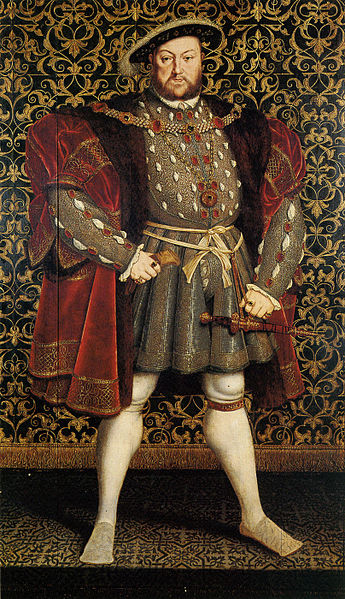
“Portrait of Henry VIII of England” by Hans Eworth, after Hans Holbein the Younger, Chatsworth House. 1560-73
Henry VIII exemplifies male dress of this period. He wears the following items:
–French Bonnet: a hat that is part pillbox and part beret, generally decorated with jewels and a feather plume.
–shirt-formerly known as a chemise. Full through the body with raglan sleeves in the Italian fashion.
–drawers-linen under shorts
–Hose- Henry VIII continues to wear the hose of previous centuries. It is full length (foot to waist) and has a codpiece. It starts to become the trend that hose is actually divided into two pieces–upper and lower sections called the (upper stocks and nether stocks), the two halves being attached together at the knee.
—a rather pronounced codpiece-most certainly padded for emphasis. This has become equally decorative as functional. It would lace into place on the hose or the upper stocks.
—a slash and puffed doublet with bases (a long peplum or “man” skirt) attached. Bases could be a separate garment as well worn with a short doublet.
–chamarre-a wide shouldered overcoat with wide lapels and puffed sleeves. Shown in red here.
—he has an order-a large chain necklace that signifies office and/or political alliance.
—extremely wide shoes called duckbills. These, of course, could be slashed and puffed.
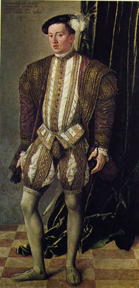
Jakob Seisenegger “Archduke Ferdinand of Tyrol” by Jakob Seisenegger, 1548.
Courtesy of Kunsthistorisches Museum, Vienna
In addition to the wide shouldered, French bonnet wearing silhouette inspired by King Henry VII, this young man wears paned upper stocks. The act of paning was a new and improved slashing and puffing technique that consisted of fabric strips that creating the desired rounded silhouette of the garment. These were usually lined in white or contrasting silk satin). In the image at left, the upper stocks resemble what will become referred to as breeches/trunk hose begining in the Elizabethan period.
Notice that he still features a codpiece (emphasized). This is the biggest clue that the evolution to breeches is not complete. This garment is still considered part of the hose arrangement–securing the two legs together.
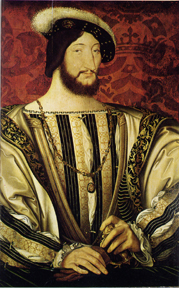
Jean Clouet, Francois I, ca 1485-1541. Louvre Museum, Paris. France.
The picture of Francis I (King of France) to the right reveals a coordinating doublet, jerkin (Jerkin becomes the word associated with the the outer most doublet) , and chamarre ensemble. The edges of the jerkin are barely visible–they create an open V neckline framing the doublet front.
He, too, wears a French bonnet.
The sleeves of his chamarre are of the style most often seen in this period: full in the armscye and tapering through elbow and wrist.
The portrait of Henri II of France was painted in 1550. His wife was Catherine de Medici from Italy. She is credited with founding the modern French perfume industry as well as being a major fashion trend setter of the time.
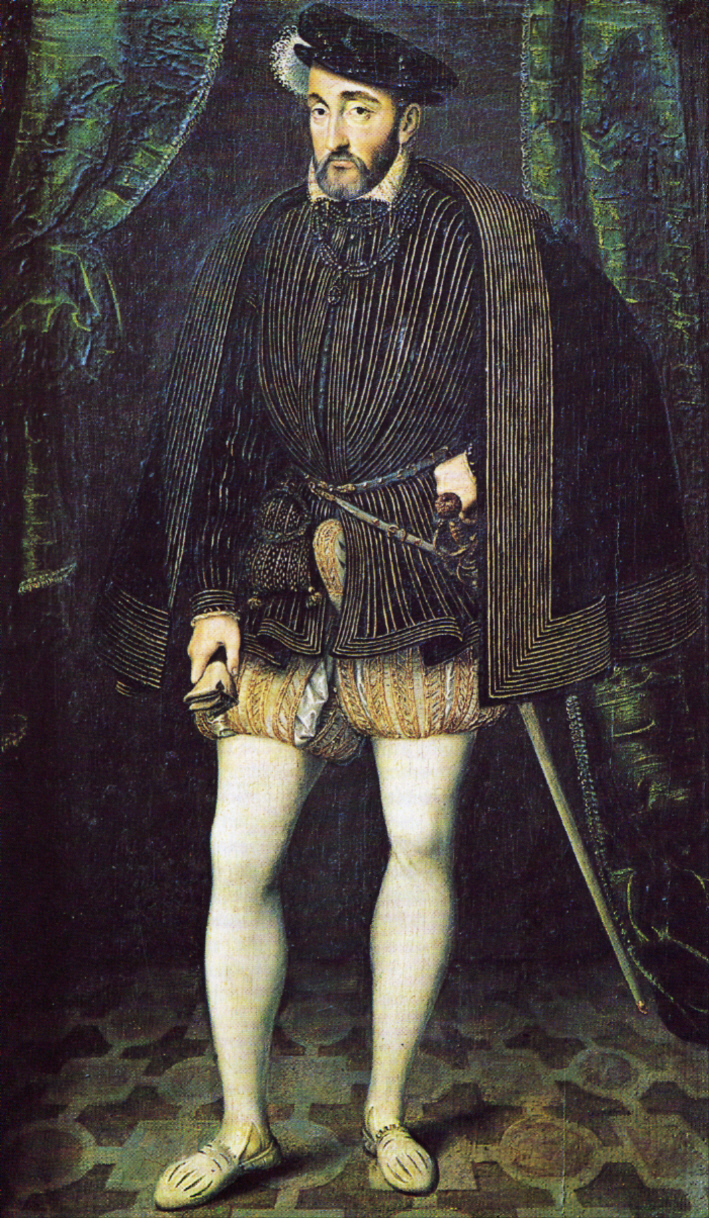
Workshop of François Clouet (1515-1572) – King of France Henry II ,с.560-1580 : The Louvre Museum, Paris. France
This image shows characteristics of both the Tudor and Elizabethan eras. The cut of his doublet/jerkin (with extra padding through the chest) and his melon shaped upper stocks (with added roundness through the hips) resemble those of the Elizabethan period.
The very pronounced codpiece will fade by the end of the Elizabethan era. His shoulders are still on the wide side, but they are not as pronounced as they had been in previous decades. Shoulders continue to decrease in size as we move into the Elizabethan period.
He is a good example that fashions evolve through time, and a reminder that it is really hard to put a concrete date on the end of one period and the beginning of the next.
Tudor Female Dress: 1530-1575
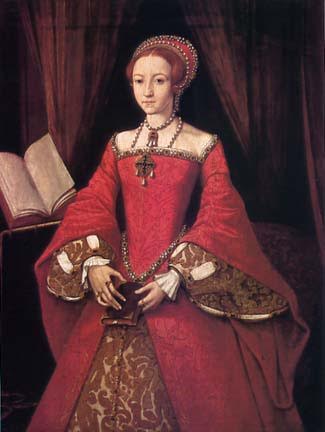
The Lady Elizabeth in about 1546, by an unknown artist
The portrait of Elizabeth I (at this time, Princess of England) below exemplifies the female Tudor silhouette–which resembles a very stiff hourglass shape.
The torso is confined into a perfect cylindrical cone through the use of stays (a stiff underbodice that laced for a tight fit. Also know as a pair of bodies, stays would have a large, flat wooden/bone busk center front to flatten & restrict the bustline.) The skirt also hangs cylindrically–supported by a hoop skirt called a vergudale also known as a Spanish Farthingale (the verudgale was constructed by sewing cane, whalebone or steel hoops of graduated sizes into a sturdy petticoat).
The skirt of her gown opens center front to reveal a very decorative petticoat/underskirt. This opening accentuates the cone silhouette of the skirt. Notice, that even the sleeves of her gown take on a triangular cone shape–fitted at the upper arm, and opening into wide funnels at the forearm. Her decorative false sleeves coordinate with her petticoat. They feature some moderate slashing and puffing, allowing her chemise to show. She wears a french hood on her head.
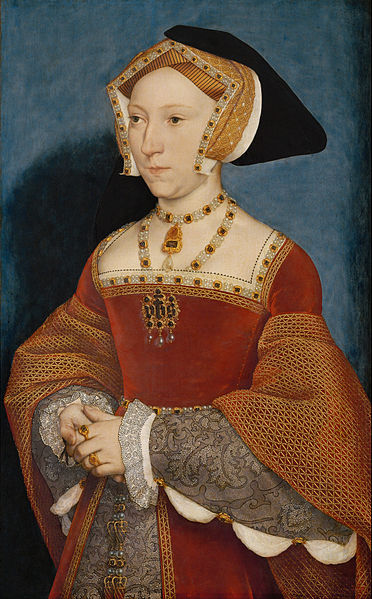
Hans Holbein the younger. Jane Seymour, Queen of England. 1536. Kunsthistorisches Museum, Vienna.
The Holbein portrait of Jane Seymour (left)–one of Henry VII ‘s many wives–features many of the attributes seen in Elizabeth’s portrait. Notice the black work at the neck edge of her gown. This decorative black embroidery becomes rather popular during the Renaissance. The color black becomes much more prominent during this time. This is a direct result of the newly discovered dyestuff–logwood–which is now finding its way into Europe from the “New World” (modern day Mexico).
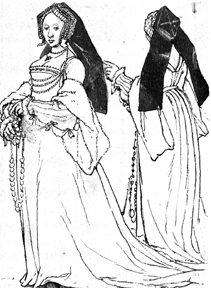
Holbein Sketch, ca 1526-28 or 1532-35
The headdress Jane wears is distinctly English. An evolution from the monster reticulated head attire of the Gothic period, the gabled headdress had a wooden or metal structure that was key in creating the square pedimental shape characteristic of this headdresss. The black fabric seen here, was generally velvet. Retaining the Gothic name fall, this fabric could be tucked up underneath the headdress to hide the hair (as seen on Jane) or it could hang down in a fashion similar to Assyrian lappets (as in the Holbein sketch).
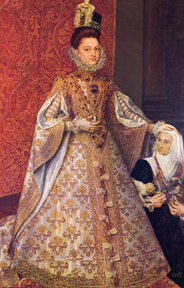
Infanta Isabel Clara Eugenia of Spain with Magdalena Ruiz by Alonso Sánchez Coello, ~1586, Madrid. Spain.
Although this painting was created during the heart of what we label “Elizabethan” (dated c.1586) I have chosen to include it amongst the Tudor silhouette for the sake of demonstrating the rigidity of the skirt silhouette.
On this note, I should remind you that the Tudor silhouette does not disappear from style during the Elizabethan period. In fact, the styles that mark Queen Elizabeth’s England and France of this time, are characteristic only in the areas considered Northern Europe.
Southern Europe would maintain this silhouette through the close of the 16th Century. (This portrait was indeed in Spain, during the Elizabethan period.) However, even in England, one might see this silhouette coexisting with the wider Elizabethan styles featured later in this review.
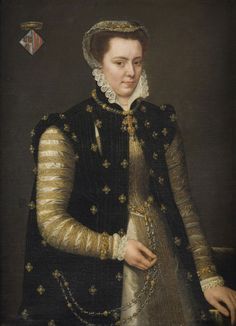
c. 1559. Portrait of Margaret of Parma Antonis Mor, Netherlandish, c. 1512/16 – c. 1576 Philadelphia Museum of Art
The portrait on the right shows us two other styles that surface during this period. The first is the ropa. It originates in Spain and functions in a manner similar to a modern coat. Ropas are generally black, and are thought to be a garment symbolic of mourning. The ropa is generally worn fastened above the bustline, and hangs in an A-line silhouette (yes, another cone…just larger) to the floor. It is often depicted with a short puff in the sleeve at the shoulder, although sleeveless versions are possible as well.
The second fashion shown here is the attifet. This headdress takes the form of a jeweled wire mesh (as shown here) or a linen cap. In either form, the silhouette is the same. The dip in the front and the rounded sides are the key identifiers for this cap.

Mary Queen of Scots, c. 1580
This rather somber portrait of Mary, Queen of Scots portrays her in the linen version of the attifet.
She is also wearing a garment that later finds favor with her cousin and rival–Elizabeth I, Queen of England. Conch is the name given to the sheer, almost transparent, cape-like garment shown here.
Elizabethan Male Dress-c. 1550-1600

Antonis Mor (Antonio Moro van Dashorst 1517-1577)- Portrait of a Gentleman, 1569.
Andrew W. Mellon Collection.
National Gallery of Art, Washington.
This image was painted in 1560. The silhouette of his costume seems to be an inversion of the previous period. Wide shoulders become narrow, while hips grow in size. Sleeves narrow, but remain padded, creating sausage-like appendages. It becomes very common for jerkins to be sleeveless, allowing the doublet sleeves to show. The trend now is for tall standing collars. The collar of the shirt shows at the very edge. It becomes common to edge that collar in a ruffle, which is destined to grow in size.
His paned melon hose resemble two large pumpkins balanced upon his hips. By the end of the period, these will transition away from being considered an element of the hose. They will be looked at as a separate garment- trunk hose/breeches. The two legs are sewn together through the “crotch” in the manner of modern pants. The codpiece is rendered obselete and disappears when this happens.
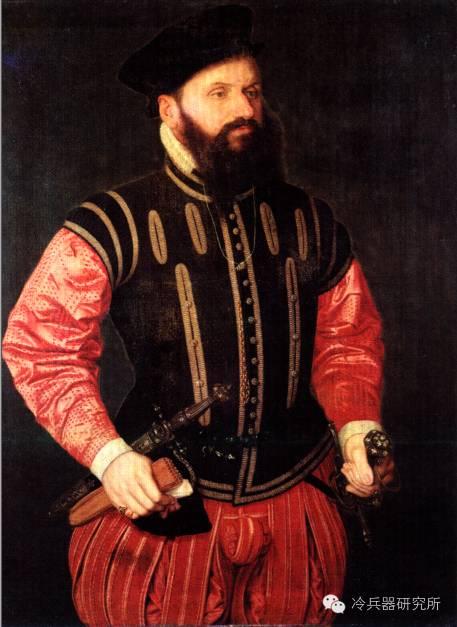
Portrait of Hieronimus Koler 1528 – 1573.
This handsome fellow is wearing a doublet, jerkin, codpiece, slashing (no puffing in this case), and ruffled shirt collar.
The male silhouette continues to evolve. Notice that the shoulders have narrowed while the hips have gotten wider. Slashing and the codpiece (two trends that disappear during Elizabeth’s reign) are still present. This is definitely a transition look.
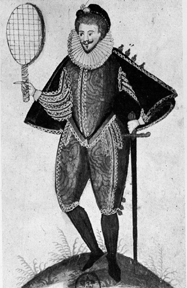
Court Paume player, 1580
The courte paume (Tennis) player below exhibits some uniquely Elizabethan elements.
The ruffle on the edge of the shirt collar has evolved into a separate garment given the name ruff. It is a creative combination of two previously under exploited inventions of the 15th century–starch and lace. Lace is pleated to a band, the resulting ruff was stiffened greatly with starch. As demonstrated by this picture, they grew in size to rival modern clown-like widths.
The belly of his doublet is padded heavily creating the effect similar to the puffed out chest of a bird–like a peacock strutting his stuff. It is given the name peascod belly in honor our our magnificently feathered peacock friends.
He is wearing breeches/trunk hose in a style called venetians. These were also heavily padded. They were wide through the hips and tapered into the knee. The shape is reminiscent of the hind quarters of a sheep–a leg of mutton shape.
The use of stockings sees a renaissance of its own. These were now knee length, knitted, and were generally laced to the breeches/trunk hose. Notice: no codpiece.
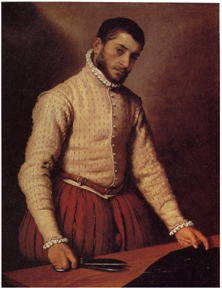
The Tailor, painting by Giovanni Battista Moroni, 1570–1575, National Gallery (London)
This merchant class fellow (a tailor) follows the fashionable trends of the Elizabethan period. Exceptionally large paned melon hose (AKA pumpkin breeches) paired with a narrow shouldered doublet and shirt with ruffled collar all make up a fashionable ensemble.
The lower classes were generally a bit behind their wealthy superiors in the race to keep up with fashion. This is why we do not see a larger ruff and the codpiece is still peeking out between the legs of his melon hose. Trends of previous periods are often maintained longer amongst the middle and lower classes depending on their resources.

Sir Walter Raleigh and his son. 1602. National Portrait Gallery. London. England
This portrait of Sir Walter Raleigh and his son exemplify cutting edge Elizabethan dress. He wears:
–a shirt and drawers (unseen)
–a ruff
—a doublet with padded sleeves under a sleeveless jerkin. Both of these garments feature a modest dip-front (V) waistline and padded peascod belly.
–His trunk hose/breeches are another variation of melon hose/pumpkin breeches. They contain less stuffing, thus they have a deflated look.
–the extensions below his trunk hose (reaching to the knee) are canions. These would be attached to the breeches.
—stockings. These reach to the knee and are held in place with garters or by attachment to the canions. They could be knitted rather than made from woven fabric. Knitting allowed stockings some elasticity to hug the leg defying gravity a bit. Full length hose would not be worn with the new breeches. Notice the absence of the codpiece.
The son wears clothing very similar to Dad. Noticable differences (which do not relate to his status of being a child at all, but rather provide examples of other acceptable dress combinations) are:
He wears the venetian version of breeches and has a square shirt collar in the place of a ruff.
Both wear rounded toe shoes–a happy middle ground in response to the out of date pointed shoes, and the suddenly fashionable wide square toed duckbills.

Extant doublet and breeches. Victoria and Albert Museum. London. England
This surviving matching doublet and breeches shows intricate slashing techniques.
The trunk hose are unpaned melon hose/pumpkin breeches.
An additional trunk hose variation is not picked on this page. They are gallygaskins/slops, These are described as: wide and full throughout the leg. They are gathered or pleated into a waistband and have the appearance of tapering out from the waist to fullness concentrated at the low thigh.
Elizabethan Female Dress:1575-c.1600

Queen Elizabeth I, the Ditchley Portrait, c. 1592. Oil on canvas, National Portrait Gallery. London. England
Here she is, good Queen Bess (Queen Elizabeth I) as a walking overstuffed couch. The farthingale is to blame for this exaggeratedly wide silhouette. Instead of constructing her farthingale out of hoops of graduated sizes, Elizabeth I chose a French Farthingale/Wheel Drum to create this look. The hoops here are all the same size, creating a “drum” like effect. A bum roll is worn underneath the wheel drum farthingale in order to provide added support, preventing gravity from doing its job. A lady desiring a much less exaggerated, but nonetheless shelf-like effect (inspired by the wheel drum look, of course) might ditch the farthingale altogether and wear only the bum roll under her skirt.
At any rate, in lands lying in Northern Europe, a widened horizontal silhouette is certainly desired. Hair is piled on top of the head, the tall medici collar/whisk style of ruff gains popularity, and sleeve caps get taller (leg-o’mutton sleeves–tall, gathered and balloon like at the shoulder and tapering below the elbow–become very popular during this time) in an effort to balance the awkward silhouette. The bodice becomes exaggerated as well–creating a very deep V below the waist. This gives the illusion of an abnormally long torso. While on the topic of exaggeration, hanging sleeves should also be mentioned. Looking like wings in this portrait of Queen Liz, decorative sleeves were very common.
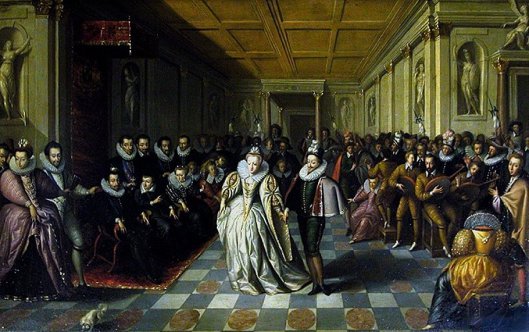
Wedding of Anne de Joyeuse with Marguerite de Vaudémont, 24 September 1581 in Le Louvre. On the left under the dai are Henri III, Catherine de Médicis, and Queen Louise. French school 1581-1582.
The result of all of this is a disproportionate, very un-naturual silhouette. All thanks to body modification.
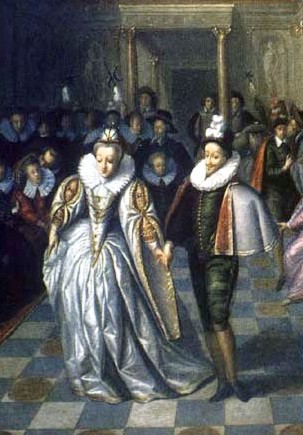
Detail of the painting above.
This lady shows another example of the previously mentioned unnatural silhouette. Notice how softly her skirt hangs when compared to the Tudor line. This is a result of the dense cartridge pleating used in the construction of her skirt and use of the lone bum roll rather than a farthingale. This style of pleating is the same construction technique used to create the pleated ruffs worn by men and women of this period.
The widths of Elizabethan ruffs become so large, that it is difficult to eat. The lady at the left, reveals a novel solution to this problem. Her ruff is open center front, keeping it out of the way of eating AND framing her cleavage quite nicely.

Princess Elisabet Vasa by an unknown artist. c. 1580. This disputed picture has long been considered to be of Karin Månsdotter, but now, it is presumed to be of Princess Elisabet Vasa; the text on the picture is believed to have been added much later.
This portrait, painted in 1580, is of a Swedish princess. She shows that there were fashionable women (even in Northern Europe) who did not fall into the ugly trap of the wheel drum farthingale or the bumroll. Although, she clearly did not avoid the ruff. The large size of her cartwheel ruff and the accentuted V at the waist in the construction of her gown are subtle hints that place her in the Elizabethan world.
Ruffs of this width are distinctly Elizabethan; as are the deep exaggerated V front waistlines.

Portrait of Margherita Gonzaga by Frans, the younger Pourbus. 1604-5. www.wikigallery.com
The same hints mentioned above are present in this Elizabethan painting of a Spanish noblewoman.
Cartwheel ruffs made it into the wardrobe of Southern European ladies, even if the wheel drum farthingale did not. Notice the exaggerated U-shaped dip in the waistline of her bodice. The shape of the busk in her stays would mirror the shape of the bodice.
I should point out to you that it is very possible that she is wearing a separate bodice and skirt. This is very common with the “drum” silhouette, and very possible here as well.

Portrait of an unknown Spanish princess by Alonso Sanchez Coello, c. 1615
This ensemble is very likely a separate bodice and skirt (notice the VERY prominent shadow line along the waistline). She has on a farthingale variation, giving her gown a silhouette somewhere in between Elizabeth’s wheel drum and the Tudor cone. Fashion is not cut and dry–fashion anomalies are par for the course, I believe that we are seeing one of these anomalies here.
She has a very tall, flat, nonpleated ruff called a whisk. This lady is ahead of her time. She foreshadows future evolutions of the ruff. This neck decoration would have a sturdy steel wire running along the seam joining the linen and the lace. This is how she is able to make this collar stand erect. The lace would be heavily starched to continue the flat plane.
QUICK REVIEW-ITALIAN TO NORTHERN RENAISSANCE
TYPE OF DRESS: tailored with complex layers including fashion fabric, lining, and “stuffing”
TEXTILES: Wool and silk for garments. Very elaborately woven and decorated textiles (brocades, satins, taffetas, cut velvets, metallic, mesh, crepe, chiffon…) , linen and cotton used for undergarments. Knitting is now commonly available for textile creation. Lace and starching is also common (especially for ruffs). Use of fur increases. Logwood is discovering, making black textiles easier to create. Spanish work (aka Black Work) embroidery on visible edges of chemises.
SILHOUETTE SHAPE: Rectangular for men, stiff hourglass for women. The second half of the century sees the men’s silhouette shift to narrow shoulders and wide hips creating a trapezoidal shape. Both genders have stiff and artificial silhouettes. Body modification (torsos) for women.
BASIC GARMENTS: Chemise, ruff, doublets, oversized jackets (chamarres), trunk hose/breeches, codpiece, bases, men’s hats (french bonnets), wide shoes (duckbills), stays, farthingale, gowns/dresses possibly in layers, petticoat, gabled headdress/french bonnet.
MOTIVATIONS FOR DRESS: Status. Showing off wealth, personality, and individuality. Regionalism
KEY IDENTIFIERS: slashed & puffed & ruffed & stuffed. Body modification for females (stays & farthingales), wide shoes, melon-sized breeches for men, square necklines, ladies’ headdress, rectangular to trapezoidal silhouettes for men, stiff hourglass for women, elaborate textiles, use of the color black.
Recent Comments